
- SAP Community
- Products and Technology
- Technology
- Technology Blogs by Members
- How to create a Project, Job and Job execution in ...
Technology Blogs by Members
Explore a vibrant mix of technical expertise, industry insights, and tech buzz in member blogs covering SAP products, technology, and events. Get in the mix!
Turn on suggestions
Auto-suggest helps you quickly narrow down your search results by suggesting possible matches as you type.
Showing results for
Former Member
Options
- Subscribe to RSS Feed
- Mark as New
- Mark as Read
- Bookmark
- Subscribe
- Printer Friendly Page
- Report Inappropriate Content
05-22-2017
5:31 PM
Purpose of this Documentation:
The main agenda behind creating this documentation is to know how to create a project, job , one to one mapping and job execution in Data Service designer.
SAP-Business Objects Data Services (BODS) Version -- 14.2.5.800
Following are the steps to proceed things in a particular manner.
Step 1:

Step 2:
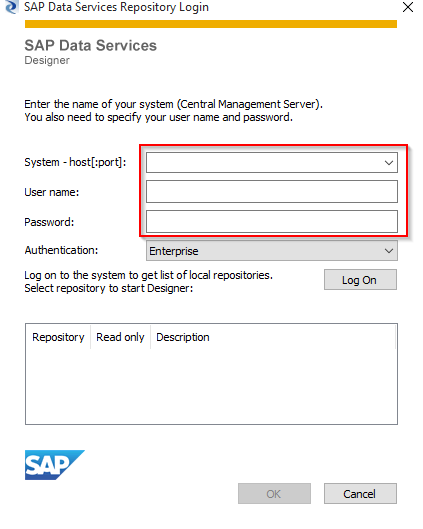
Step 3:

Step 4:

Step 5:

Step:6
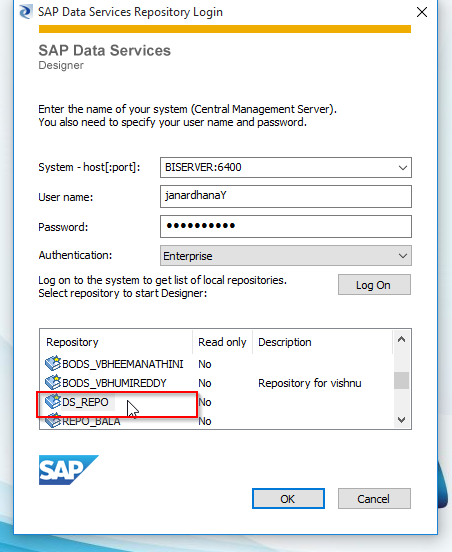
Step 7:
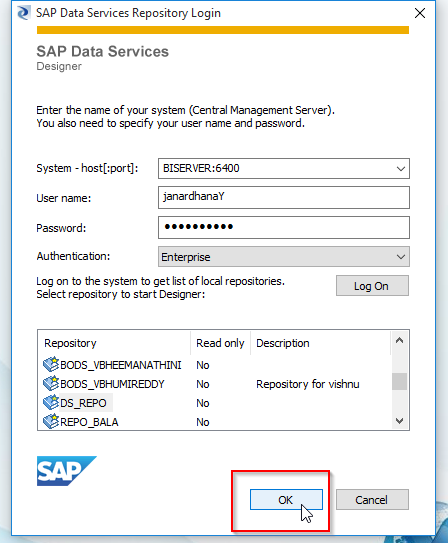
Step 8:
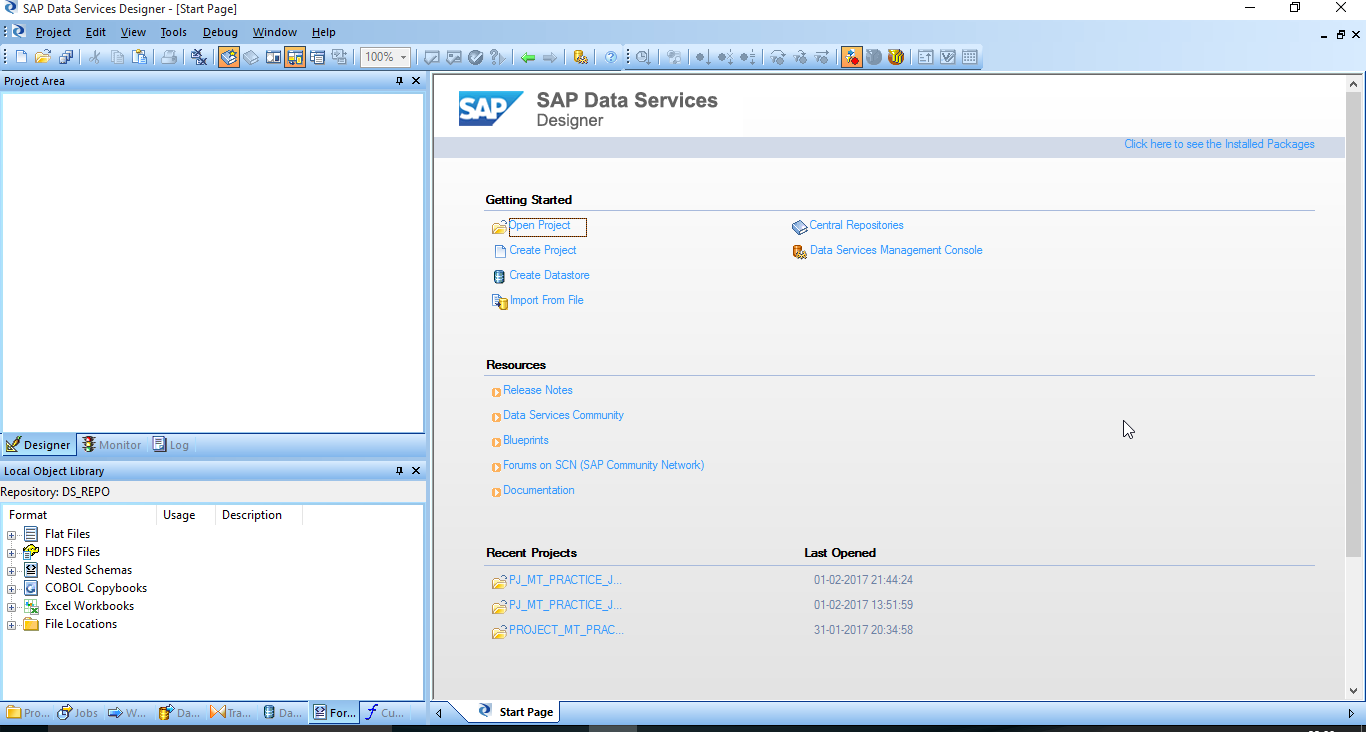
Step 9:
1.Structure area
2.Project area
3.Local object Library
This picture is belongs to Structure area

------------This picture belongs to project area

----------This picture belongs to Local object library
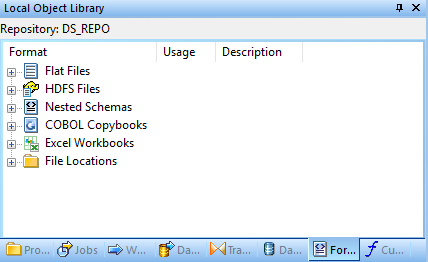
Step 10:
1.Go to structure area and right click on that new project then "project new" window will be open and we have to enter the name of the project and click on "create".
Step 11:
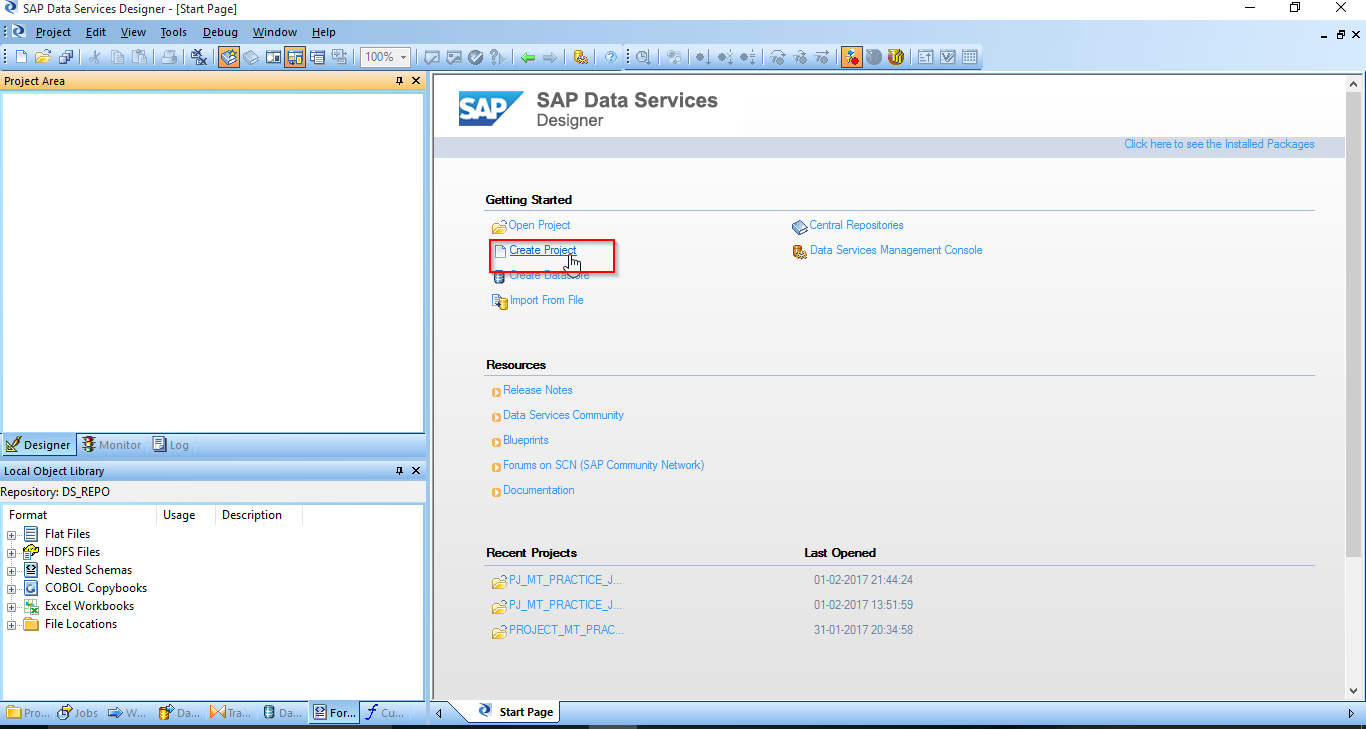
Step :12
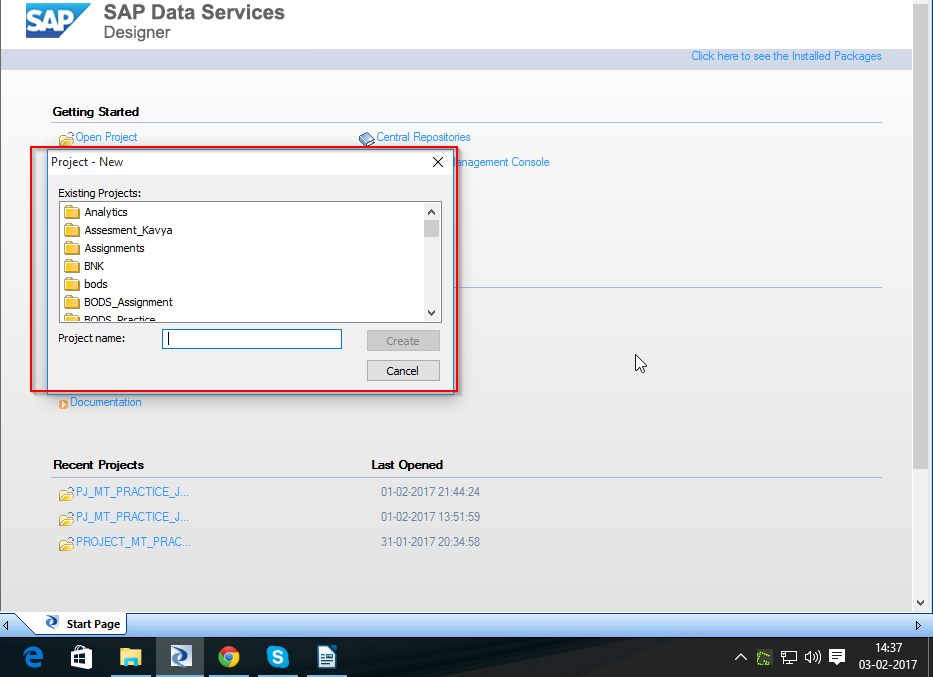
Step 13:

Step 14:
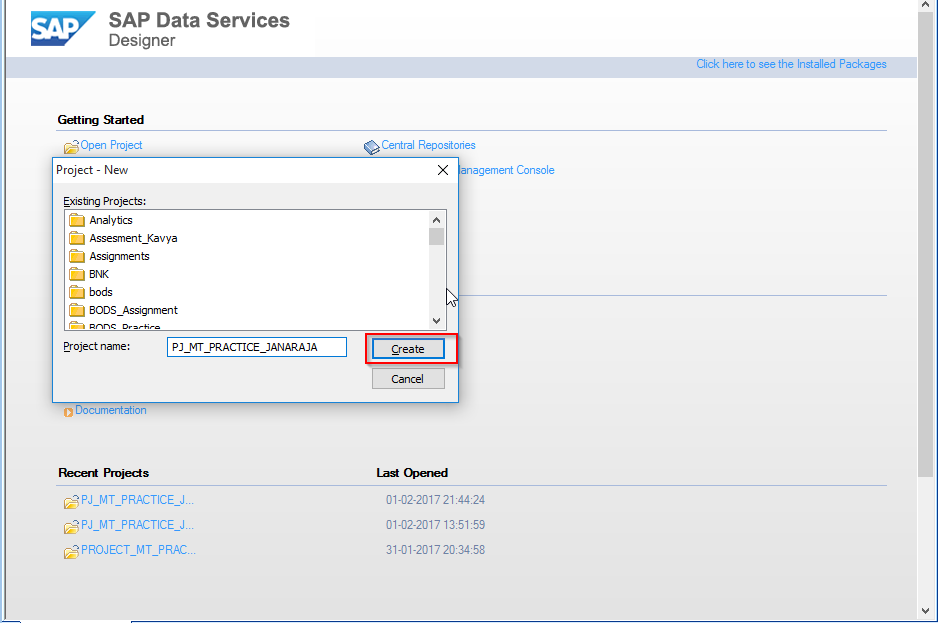
Step 15:
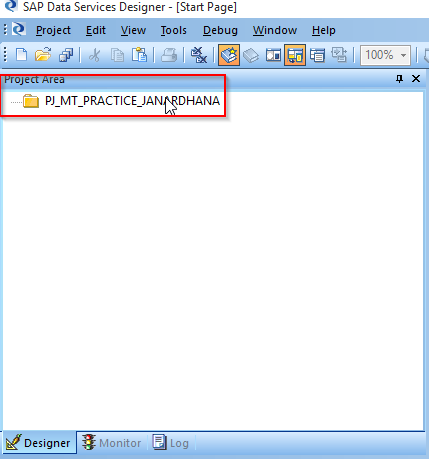
Step 16:

Step 17:
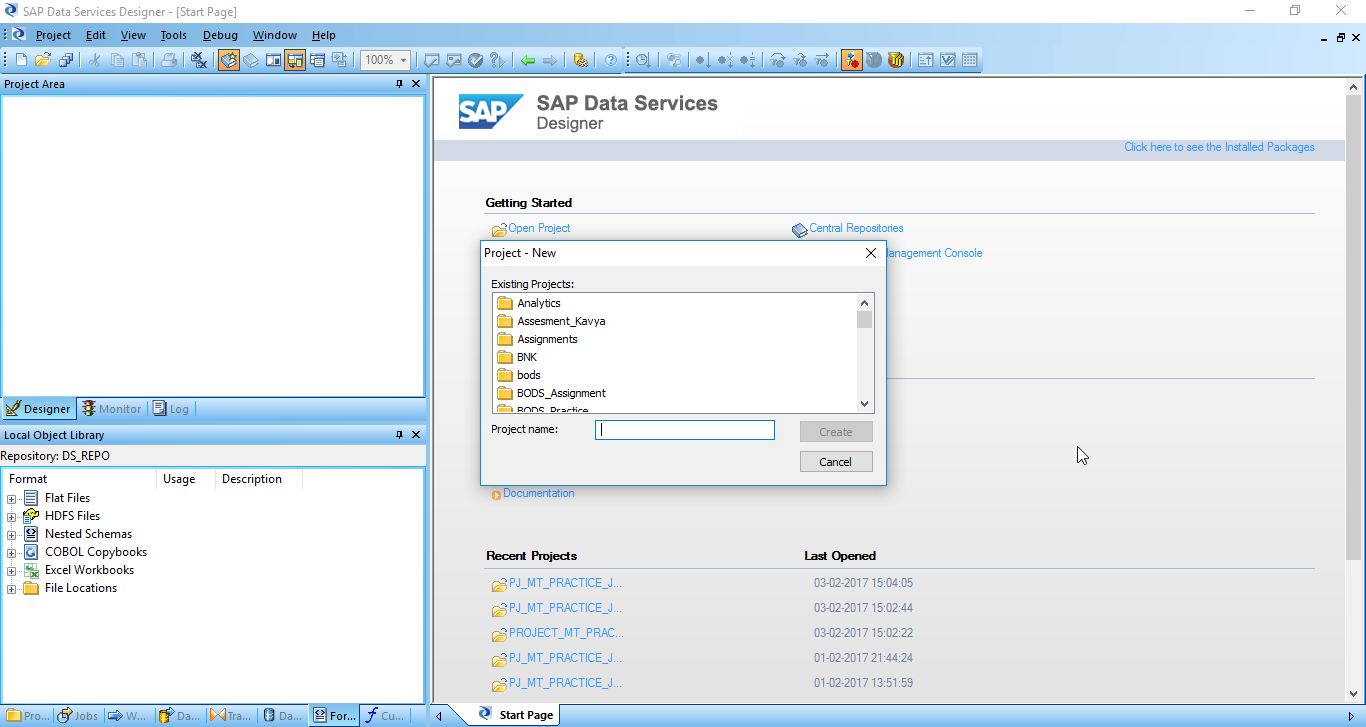
Now project creation is same what i was explained in previous steps of project creation.
Step 18:

Step 19:
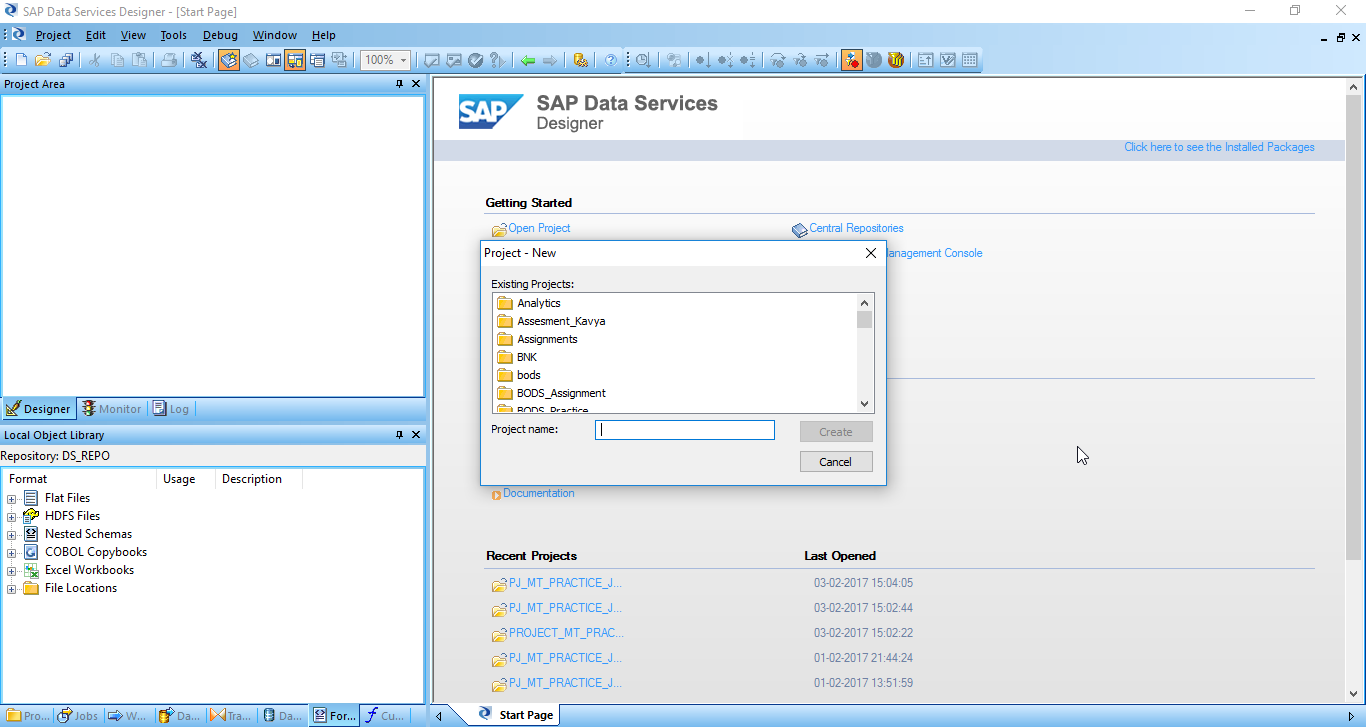
Now project creation is same what i was explained in previous steps of project creation.
Step 20:
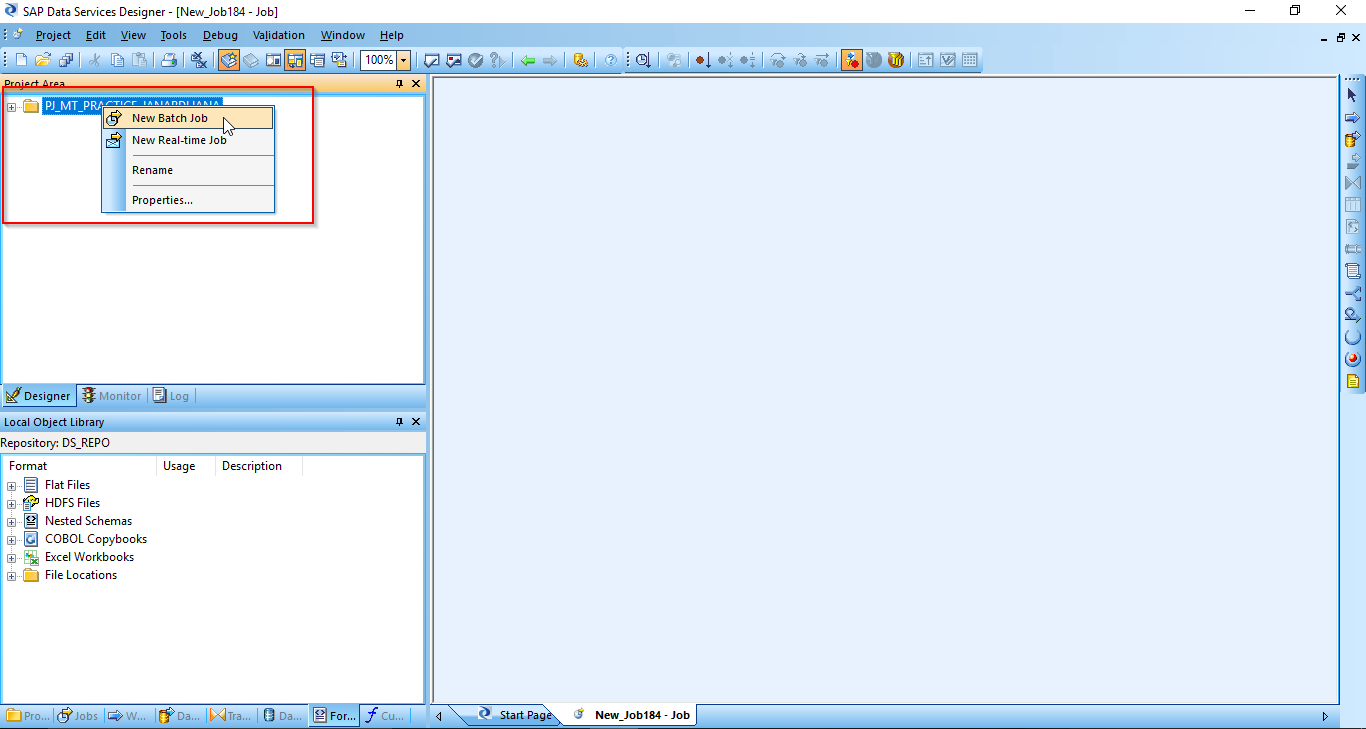
Step 21:

Step 22:

Step 23:
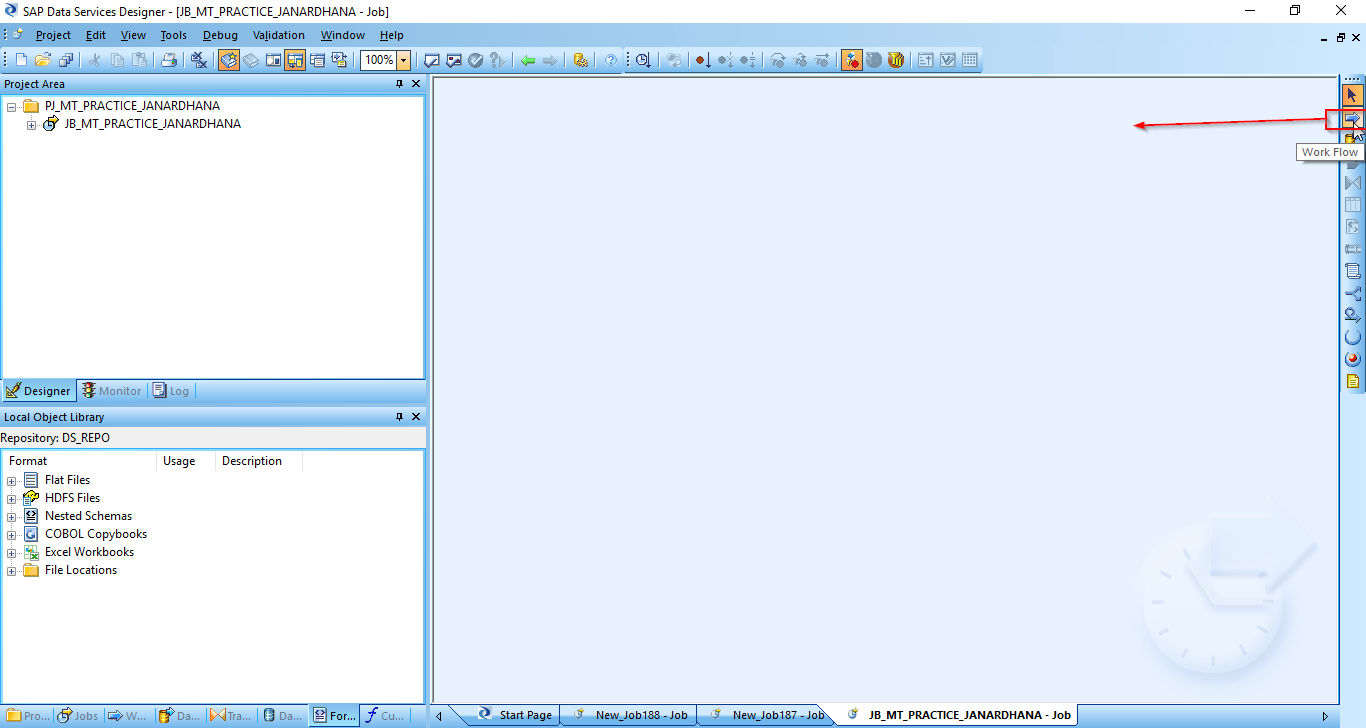
Step 24:
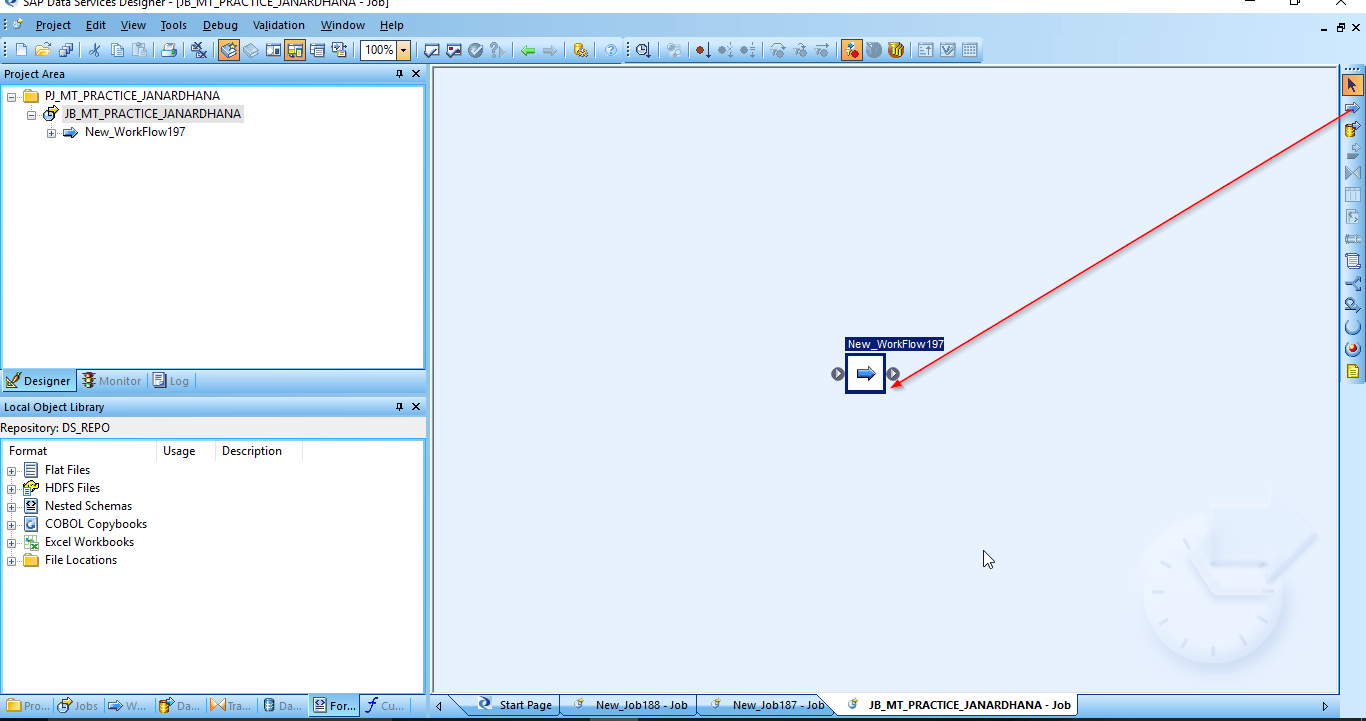
Step 25:

Step 26:

Step 27:

Step 28:

Step 29:

Step 30:

Step 31:

Step 32:

Step 33:

Step 34:

Step 35:

Step 36:
Note: The following steps are depending upon the company rules what i will mention in below picture .

Step 37:

Step 38:

Step 39:

Step 40:

Step 41:

Step 42:

Step 43:
Now a window pops up with YES or NO options then we have select yes option
Step 44:
1.NAME
2.column
3.Skip row header
Please follow the below picture for how to change.
Picture-1:
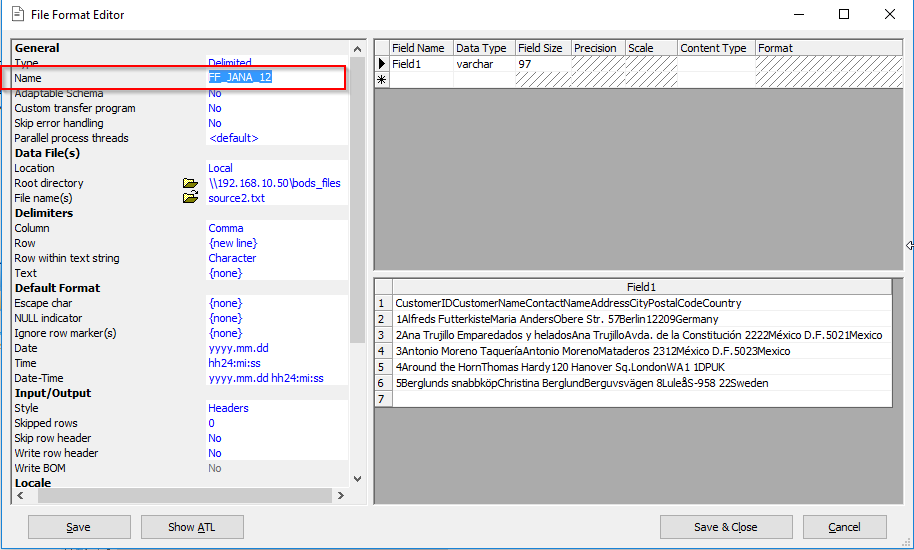
Picture 2:
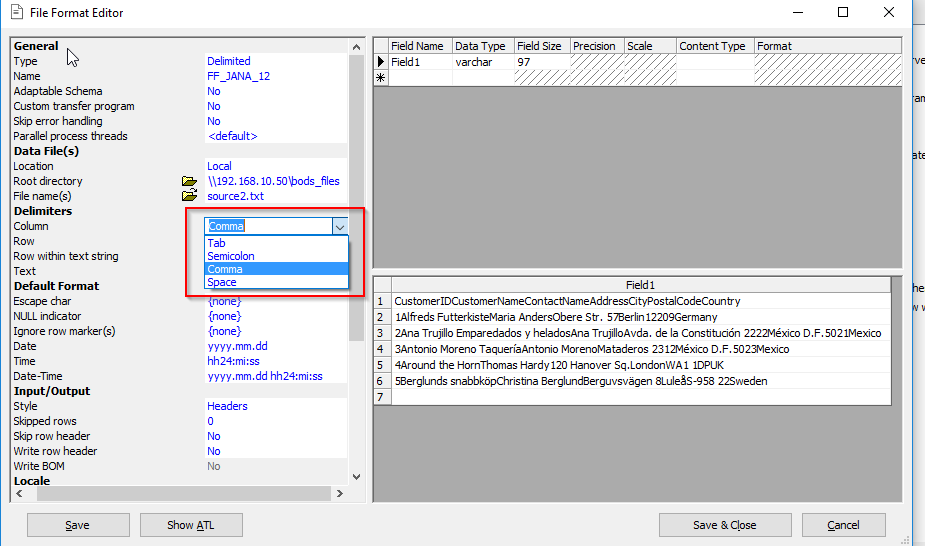
Picture 3:

Step 45:
Step 46:
Now go to flat files and check whether the require files is there or not.

Step 47:

Step 48:

step 49:

Step 50:

Step 51:

Step 52:

Step 53:

Step 54:

Step 55:

Step 56:
Step 57:

Step 58:

step 59:

Step 60:

Step 61:

Step 62:

Step 63:

Thank You!
The main agenda behind creating this documentation is to know how to create a project, job , one to one mapping and job execution in Data Service designer.
SAP-Business Objects Data Services (BODS) Version -- 14.2.5.800
Following are the steps to proceed things in a particular manner.
Step 1:
- Click on windows button and then select the Data Service Designer.

Step 2:
- After clicking on that designer "SAP Data Service repository login" dialogue box will be displayed on your system.

Step 3:
- We have to enter the required credentials.

Step 4:
- Then after click on the Log On button.

Step 5:
- After click on Log On button we can able see some repositories.

Step:6
- Choose the repository whatever we have assigned.

Step 7:
- Click on "OK" Button.

Step 8:
- SAP Data Service designer window will be opened after clicking OK.

Step 9:
- Designer window is divided the screen into 3 parts
1.Structure area
2.Project area
3.Local object Library
- Please follow the below pictures for an easy way to find the allocated areas of Designer.
This picture is belongs to Structure area

------------This picture belongs to project area

----------This picture belongs to Local object library

Step 10:
- Now we can able create new project here also we have 3 ways to create new project.
1.Go to structure area and right click on that new project then "project new" window will be open and we have to enter the name of the project and click on "create".
- Please follow the picture for how to create new project in structure area.
Step 11:
- Click on the Create Project.

Step :12
- Then project window will be displayed

Step 13:
- we have to enter project name as per the Client requirement.

Step 14:
- Click on create option

Step 15:
- Now new project will be created on project area

Step 16:
- Alternate option for project creation is
- Go to project area and click on the project and select new project

Step 17:
- Now "project new" window will be opened.

Now project creation is same what i was explained in previous steps of project creation.
Step 18:
- 3rd option for project creation
- Go to upper pallet and click on symbol of the highlighted part.

Step 19:
- Now "project new" window will be open

Now project creation is same what i was explained in previous steps of project creation.
Step 20:
- Now we are going to create job
- Go to project area and click on the project and choose "New batch job"

Step 21:
- Click on the New batch job then one small dialogue box will be opened.

Step 22:
- Rename the job what we wanted to keep.

Step 23:
- Now we can create work flow. Go to right side pallet and choose the work flow symbol

Step 24:
- Click on that symbol and drag to structure area

Step 25:
- Now we can change the name of work flow as per the requirement.

Step 26:
- Now we have to create Data flow. Go to right side pallet and select Data flow symbol.

Step 27:
- Click on the data flow symbol and drag into structure area

Step 28:
- Now we can change the name of Data flow as per the requirement

Step 29:
- Now we will be knowing about one to one query mapping of flat files
- we can able to do query mapping in only Data flow
- Flat files are located in local object library. please see the highlighted portion in below picture

Step 30:
- Click on that symbol then flat files will retrieved in local object library.

Step 31:
- Click on that flat files and choose new option to import new flat files.

Step 32:
- Then click on that new option now then "File format Editor" window will be open.

Step 33:
- We have to rename the name option as per the requirement.

Step 34:
- Delete selected name and we have to give required name

Step 35:
- Now we have come to root directory and paste selected path there.

Step 36:
- We have to go to require flat file area and selected and select that path
Note: The following steps are depending upon the company rules what i will mention in below picture .
- Click windows+R button then run dialogue box will be open.

Step 37:
- Enter the require path in run dialogue box and then click on OK button.

Step 38:
- Now path location will be opened then we will copy the path location as highlighted.

Step 39:
- Now we will paste the path location near Root directory of file format editor.

Step 40:
- Now double click on "file name(s)" symbol

Step 41:
- Now path location will be opened that we have provided at root directory.

Step 42:
- Select which file you have to take as a source file and click on open button

Step 43:
Now a window pops up with YES or NO options then we have select yes option

Step 44:
- We have to rename the following columns as per the requirement, there are
1.NAME
2.column
3.Skip row header
Please follow the below picture for how to change.
Picture-1:

Picture 2:
- Select which option you want.

Picture 3:

Step 45:
- Now click on "save" and save&close" option.
Step 46:
- Now we can able to see the our source file in "Local object Library"
Now go to flat files and check whether the require files is there or not.

Step 47:
- Now we will go to structure area and do one to one query mapping.
- First click on source file and drag into structure area and select "make source" option

Step 48:
- Click on "make source" then source file will be created on designer area.

step 49:
- Now we will rename the source file for easy identity.

Step 50:
- Now go to Right side pallet and single click on mapping symbol and drag into designer area.

Step 51:
- Now we have to do mapping the source file with the query via an arrow.

Step 52:
- Now mapping area captures the data from source file
- Double click on that query mapping then "Schema in","schema out" and "Schema remapping area's will be opened.

Step 53:
- Now we have to transfer the data from schema in to schema out.
- Select all data from schema in and copy at schema out.
- If you want only required data just drag required columns from schema in to schema out.

Step 54:
- Come to data flow and single click on "template table symbol" and drag into structure area as a "Target file"

Step 55:
- Now one dialog box will be opened in structure area then we will be creating template as target table.
- Now we want to enter table name what we require.
- Select the data store what we require and click OK button.

Step 56:
- Now the target file will be created in structure area.

Step 57:
- Now we will be mapping the query to target table

Step 58:
- Go to query editor and click on "save all" option then "save all changes" window will be opened in structure area and click "ok" button after save all changes in dataflow.

step 59:
- Now target file is stored in data-store.

Step 60:
- Now go to upper pallet and click on "validate" option then one output window will be open, If there are no errors that means everything is fine in mapping.

Step 61:
- Now go to job execution
- Go to project area and right click on the job and execute

Step 62:
- Then execution properties window will be open, check the job server and click OK button

Step 63:
- After clicking OK button you will be able to see the job result in designer area.

Thank You!
- SAP Managed Tags:
- SAP Data Services
1 Comment
You must be a registered user to add a comment. If you've already registered, sign in. Otherwise, register and sign in.
Labels in this area
-
"automatische backups"
1 -
"regelmäßige sicherung"
1 -
505 Technology Updates 53
1 -
ABAP
14 -
ABAP API
1 -
ABAP CDS Views
2 -
ABAP CDS Views - BW Extraction
1 -
ABAP CDS Views - CDC (Change Data Capture)
1 -
ABAP class
2 -
ABAP Cloud
2 -
ABAP Development
5 -
ABAP in Eclipse
1 -
ABAP Platform Trial
1 -
ABAP Programming
2 -
abap technical
1 -
access data from SAP Datasphere directly from Snowflake
1 -
Access data from SAP datasphere to Qliksense
1 -
Accrual
1 -
action
1 -
adapter modules
1 -
Addon
1 -
Adobe Document Services
1 -
ADS
1 -
ADS Config
1 -
ADS with ABAP
1 -
ADS with Java
1 -
ADT
2 -
Advance Shipping and Receiving
1 -
Advanced Event Mesh
3 -
AEM
1 -
AI
7 -
AI Launchpad
1 -
AI Projects
1 -
AIML
9 -
Alert in Sap analytical cloud
1 -
Amazon S3
1 -
Analytical Dataset
1 -
Analytical Model
1 -
Analytics
1 -
Analyze Workload Data
1 -
annotations
1 -
API
1 -
API and Integration
3 -
API Call
2 -
Application Architecture
1 -
Application Development
5 -
Application Development for SAP HANA Cloud
3 -
Applications and Business Processes (AP)
1 -
Artificial Intelligence
1 -
Artificial Intelligence (AI)
4 -
Artificial Intelligence (AI) 1 Business Trends 363 Business Trends 8 Digital Transformation with Cloud ERP (DT) 1 Event Information 462 Event Information 15 Expert Insights 114 Expert Insights 76 Life at SAP 418 Life at SAP 1 Product Updates 4
1 -
Artificial Intelligence (AI) blockchain Data & Analytics
1 -
Artificial Intelligence (AI) blockchain Data & Analytics Intelligent Enterprise
1 -
Artificial Intelligence (AI) blockchain Data & Analytics Intelligent Enterprise Oil Gas IoT Exploration Production
1 -
Artificial Intelligence (AI) blockchain Data & Analytics Intelligent Enterprise sustainability responsibility esg social compliance cybersecurity risk
1 -
ASE
1 -
ASR
2 -
ASUG
1 -
Attachments
1 -
Authorisations
1 -
Automating Processes
1 -
Automation
1 -
aws
2 -
Azure
1 -
Azure AI Studio
1 -
B2B Integration
1 -
Backorder Processing
1 -
Backup
1 -
Backup and Recovery
1 -
Backup schedule
1 -
BADI_MATERIAL_CHECK error message
1 -
Bank
1 -
BAS
1 -
basis
2 -
Basis Monitoring & Tcodes with Key notes
2 -
Batch Management
1 -
BDC
1 -
Best Practice
1 -
bitcoin
1 -
Blockchain
3 -
BOP in aATP
1 -
BOP Segments
1 -
BOP Strategies
1 -
BOP Variant
1 -
BPC
1 -
BPC LIVE
1 -
BTP
11 -
BTP Destination
2 -
Business AI
1 -
Business and IT Integration
1 -
Business application stu
1 -
Business Architecture
1 -
Business Communication Services
1 -
Business Continuity
1 -
Business Data Fabric
3 -
Business Partner
12 -
Business Partner Master Data
10 -
Business Technology Platform
2 -
Business Trends
1 -
CA
1 -
calculation view
1 -
CAP
2 -
Capgemini
1 -
Catalyst for Efficiency: Revolutionizing SAP Integration Suite with Artificial Intelligence (AI) and
1 -
CCMS
2 -
CDQ
12 -
CDS
2 -
Cental Finance
1 -
Certificates
1 -
CFL
1 -
Change Management
1 -
chatbot
1 -
chatgpt
3 -
CL_SALV_TABLE
2 -
Class Runner
1 -
Classrunner
1 -
Cloud ALM Monitoring
1 -
Cloud ALM Operations
1 -
cloud connector
1 -
Cloud Extensibility
1 -
Cloud Foundry
3 -
Cloud Integration
6 -
Cloud Platform Integration
2 -
cloudalm
1 -
communication
1 -
Compensation Information Management
1 -
Compensation Management
1 -
Compliance
1 -
Compound Employee API
1 -
Configuration
1 -
Connectors
1 -
Conversion
1 -
Cosine similarity
1 -
cryptocurrency
1 -
CSI
1 -
ctms
1 -
Custom chatbot
3 -
Custom Destination Service
1 -
custom fields
1 -
Customer Experience
1 -
Customer Journey
1 -
Customizing
1 -
Cyber Security
2 -
Data
1 -
Data & Analytics
1 -
Data Aging
1 -
Data Analytics
2 -
Data and Analytics (DA)
1 -
Data Archiving
1 -
Data Back-up
1 -
Data Governance
5 -
Data Integration
2 -
Data Quality
12 -
Data Quality Management
12 -
Data Synchronization
1 -
data transfer
1 -
Data Unleashed
1 -
Data Value
8 -
database tables
1 -
Datasphere
2 -
datenbanksicherung
1 -
dba cockpit
1 -
dbacockpit
1 -
Debugging
2 -
Delimiting Pay Components
1 -
Delta Integrations
1 -
Destination
3 -
Destination Service
1 -
Developer extensibility
1 -
Developing with SAP Integration Suite
1 -
Devops
1 -
Digital Transformation
1 -
Documentation
1 -
Dot Product
1 -
DQM
1 -
dump database
1 -
dump transaction
1 -
e-Invoice
1 -
E4H Conversion
1 -
Eclipse ADT ABAP Development Tools
2 -
edoc
1 -
edocument
1 -
ELA
1 -
Embedded Consolidation
1 -
Embedding
1 -
Embeddings
1 -
Employee Central
1 -
Employee Central Payroll
1 -
Employee Central Time Off
1 -
Employee Information
1 -
Employee Rehires
1 -
Enable Now
1 -
Enable now manager
1 -
endpoint
1 -
Enhancement Request
1 -
Enterprise Architecture
1 -
ETL Business Analytics with SAP Signavio
1 -
Euclidean distance
1 -
Event Dates
1 -
Event Driven Architecture
1 -
Event Mesh
2 -
Event Reason
1 -
EventBasedIntegration
1 -
EWM
1 -
EWM Outbound configuration
1 -
EWM-TM-Integration
1 -
Existing Event Changes
1 -
Expand
1 -
Expert
2 -
Expert Insights
1 -
Fiori
14 -
Fiori Elements
2 -
Fiori SAPUI5
12 -
Flask
1 -
Full Stack
8 -
Funds Management
1 -
General
1 -
Generative AI
1 -
Getting Started
1 -
GitHub
8 -
Grants Management
1 -
groovy
1 -
GTP
1 -
HANA
5 -
HANA Cloud
2 -
Hana Cloud Database Integration
2 -
HANA DB
1 -
HANA XS Advanced
1 -
Historical Events
1 -
home labs
1 -
HowTo
1 -
HR Data Management
1 -
html5
8 -
idm
1 -
Implementation
1 -
input parameter
1 -
instant payments
1 -
integration
3 -
Integration Advisor
1 -
Integration Architecture
1 -
Integration Center
1 -
Integration Suite
1 -
intelligent enterprise
1 -
Java
1 -
job
1 -
Job Information Changes
1 -
Job-Related Events
1 -
Job_Event_Information
1 -
joule
4 -
Journal Entries
1 -
Just Ask
1 -
Kerberos for ABAP
8 -
Kerberos for JAVA
8 -
Launch Wizard
1 -
Learning Content
2 -
Life at SAP
1 -
lightning
1 -
Linear Regression SAP HANA Cloud
1 -
local tax regulations
1 -
LP
1 -
Machine Learning
2 -
Marketing
1 -
Master Data
3 -
Master Data Management
14 -
Maxdb
2 -
MDG
1 -
MDGM
1 -
MDM
1 -
Message box.
1 -
Messages on RF Device
1 -
Microservices Architecture
1 -
Microsoft Universal Print
1 -
Middleware Solutions
1 -
Migration
5 -
ML Model Development
1 -
Modeling in SAP HANA Cloud
8 -
Monitoring
3 -
MTA
1 -
Multi-Record Scenarios
1 -
Multiple Event Triggers
1 -
Neo
1 -
New Event Creation
1 -
New Feature
1 -
Newcomer
1 -
NodeJS
1 -
ODATA
2 -
OData APIs
1 -
odatav2
1 -
ODATAV4
1 -
ODBC
1 -
ODBC Connection
1 -
Onpremise
1 -
open source
2 -
OpenAI API
1 -
Oracle
1 -
PaPM
1 -
PaPM Dynamic Data Copy through Writer function
1 -
PaPM Remote Call
1 -
PAS-C01
1 -
Pay Component Management
1 -
PGP
1 -
Pickle
1 -
PLANNING ARCHITECTURE
1 -
Popup in Sap analytical cloud
1 -
PostgrSQL
1 -
POSTMAN
1 -
Process Automation
2 -
Product Updates
4 -
PSM
1 -
Public Cloud
1 -
Python
4 -
Qlik
1 -
Qualtrics
1 -
RAP
3 -
RAP BO
2 -
Record Deletion
1 -
Recovery
1 -
recurring payments
1 -
redeply
1 -
Release
1 -
Remote Consumption Model
1 -
Replication Flows
1 -
Research
1 -
Resilience
1 -
REST
1 -
REST API
1 -
Retagging Required
1 -
Risk
1 -
Rolling Kernel Switch
1 -
route
1 -
rules
1 -
S4 HANA
1 -
S4 HANA Cloud
1 -
S4 HANA On-Premise
1 -
S4HANA
3 -
S4HANA_OP_2023
2 -
SAC
10 -
SAC PLANNING
9 -
SAP
4 -
SAP ABAP
1 -
SAP Advanced Event Mesh
1 -
SAP AI Core
8 -
SAP AI Launchpad
8 -
SAP Analytic Cloud Compass
1 -
Sap Analytical Cloud
1 -
SAP Analytics Cloud
4 -
SAP Analytics Cloud for Consolidation
1 -
SAP Analytics Cloud Story
1 -
SAP analytics clouds
1 -
SAP BAS
1 -
SAP Basis
6 -
SAP BODS
1 -
SAP BODS certification.
1 -
SAP BTP
20 -
SAP BTP Build Work Zone
2 -
SAP BTP Cloud Foundry
5 -
SAP BTP Costing
1 -
SAP BTP CTMS
1 -
SAP BTP Innovation
1 -
SAP BTP Migration Tool
1 -
SAP BTP SDK IOS
1 -
SAP Build
11 -
SAP Build App
1 -
SAP Build apps
1 -
SAP Build CodeJam
1 -
SAP Build Process Automation
3 -
SAP Build work zone
10 -
SAP Business Objects Platform
1 -
SAP Business Technology
2 -
SAP Business Technology Platform (XP)
1 -
sap bw
1 -
SAP CAP
1 -
SAP CDC
1 -
SAP CDP
1 -
SAP Certification
1 -
SAP Cloud ALM
4 -
SAP Cloud Application Programming Model
1 -
SAP Cloud Integration for Data Services
1 -
SAP cloud platform
8 -
SAP Companion
1 -
SAP CPI
3 -
SAP CPI (Cloud Platform Integration)
2 -
SAP CPI Discover tab
1 -
sap credential store
1 -
SAP Customer Data Cloud
1 -
SAP Customer Data Platform
1 -
SAP Data Intelligence
1 -
SAP Data Services
1 -
SAP DATABASE
1 -
SAP Dataspher to Non SAP BI tools
1 -
SAP Datasphere
9 -
SAP DRC
1 -
SAP EWM
1 -
SAP Fiori
2 -
SAP Fiori App Embedding
1 -
Sap Fiori Extension Project Using BAS
1 -
SAP GRC
1 -
SAP HANA
1 -
SAP HCM (Human Capital Management)
1 -
SAP HR Solutions
1 -
SAP IDM
1 -
SAP Integration Suite
9 -
SAP Integrations
4 -
SAP iRPA
2 -
SAP Learning Class
1 -
SAP Learning Hub
1 -
SAP Odata
2 -
SAP on Azure
1 -
SAP PartnerEdge
1 -
sap partners
1 -
SAP Password Reset
1 -
SAP PO Migration
1 -
SAP Prepackaged Content
1 -
SAP Process Automation
2 -
SAP Process Integration
2 -
SAP Process Orchestration
1 -
SAP S4HANA
2 -
SAP S4HANA Cloud
1 -
SAP S4HANA Cloud for Finance
1 -
SAP S4HANA Cloud private edition
1 -
SAP Sandbox
1 -
SAP STMS
1 -
SAP SuccessFactors
2 -
SAP SuccessFactors HXM Core
1 -
SAP Time
1 -
SAP TM
2 -
SAP Trading Partner Management
1 -
SAP UI5
1 -
SAP Upgrade
1 -
SAP-GUI
8 -
SAP_COM_0276
1 -
SAPBTP
1 -
SAPCPI
1 -
SAPEWM
1 -
sapmentors
1 -
saponaws
2 -
SAPUI5
4 -
schedule
1 -
Secure Login Client Setup
8 -
security
9 -
Selenium Testing
1 -
SEN
1 -
SEN Manager
1 -
service
1 -
SET_CELL_TYPE
1 -
SET_CELL_TYPE_COLUMN
1 -
SFTP scenario
2 -
Simplex
1 -
Single Sign On
8 -
Singlesource
1 -
SKLearn
1 -
soap
1 -
Software Development
1 -
SOLMAN
1 -
solman 7.2
2 -
Solution Manager
3 -
sp_dumpdb
1 -
sp_dumptrans
1 -
SQL
1 -
sql script
1 -
SSL
8 -
SSO
8 -
SuccessFactors
1 -
SuccessFactors Time Tracking
1 -
Sybase
1 -
system copy method
1 -
System owner
1 -
Table splitting
1 -
Tax Integration
1 -
Technical article
1 -
Technical articles
1 -
Technology Updates
1 -
Technology Updates
1 -
Technology_Updates
1 -
Threats
1 -
Time Collectors
1 -
Time Off
2 -
Tips and tricks
2 -
Tools
1 -
Trainings & Certifications
1 -
Transport in SAP BODS
1 -
Transport Management
1 -
TypeScript
1 -
unbind
1 -
Unified Customer Profile
1 -
UPB
1 -
Use of Parameters for Data Copy in PaPM
1 -
User Unlock
1 -
VA02
1 -
Vector Database
1 -
Vector Engine
1 -
Visual Studio Code
1 -
VSCode
1 -
Web SDK
1 -
work zone
1 -
workload
1 -
xsa
1 -
XSA Refresh
1
- « Previous
- Next »
Related Content
- Deep dive into Q4 2023, What’s New in SAP Cloud ALM for Implementation Blog Series in Technology Blogs by SAP
- Setup of Synthetic User Monitoring in SAP Cloud ALM in Technology Blogs by Members
- Overview: SAP Ariba SSO with SAP Cloud Identity Services - Identity Authentication in Technology Blogs by SAP
- Workload Analysis for HANA Platform Series - 3. Identify the Memory Consumption in Technology Blogs by SAP
- AI Foundation on SAP BTP: Q1 2024 Release Highlights in Technology Blogs by SAP
Top kudoed authors
| User | Count |
|---|---|
| 8 | |
| 8 | |
| 7 | |
| 6 | |
| 4 | |
| 4 | |
| 4 | |
| 4 | |
| 3 | |
| 3 |
